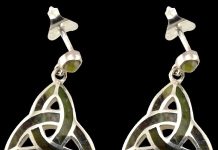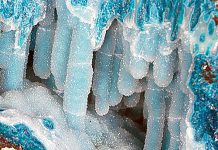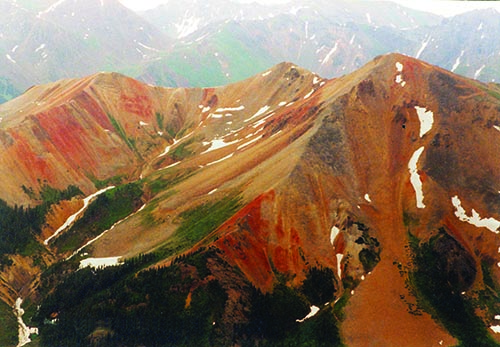
By Bob Jones
While in Denver enjoying the excellent shows, I hope you have planned extra time so you can do some sightseeing in Colorado. September is the time to get around the state, one of the most scenic in this country. Not only is it scenery-rich, but it is mineral-rich as well. With rhodochrosite leading the way, the state has much to offer collectors.
Must-See Sights While Out West
Rocky Mountain scenery is breathtaking. The old mining camps are fascinating, full of history, and the locals are well aware of the region’s mineral history. Legends about the mining camps and the local characters are fun to read about, as are the mines that have been so rich.
Today there are mines you can visit underground, narrow gauge trains, all of which were established to bring the riches of the mountains to civilization. They take you to the mining camps they served decades ago.
September is the very best time to go sightseeing in Colorado after the Denver shows. The weather is mild and sunny, with chilly nights. The famous aspen trees of Colorado provide bright yellow curtains and slashes across mountains in contrast to the dark green evergreens.
Inviting Old Mining Towns
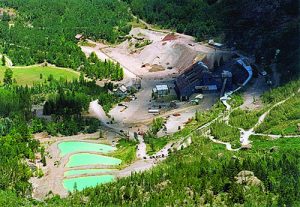
There is so much to see in Colorado. Old mining towns like Cripple Creek, Silverton, Leadville, and others beckon you with their old structures, mine head frames, and activities related to mining and minerals. Riding the old narrow gage railroads is a great way to photograph the scenery and reach old mining towns.
If you make it into Southwest Colorado, you can ride the famous and much-filmed Durango-Silverton narrow gauge train as it heads into the heart of San Juan Mountain country. Silverton is one of the last relatively unspoiled mountain mining camps. It boasts mineral shops, good restaurants, and even a fun underground silver mine tour.
The gold and silver mines around Silverton were serviced by sky-high aerial tramways, the remains of which are still there. You can visualize when these mines and tramways were active and imagine miners riding the tram buckets to go to work and ride back down to town. Hollywood movie moguls saw the potential here years ago and often filmed the Durango-Silverton train and even brought in Jimmy Stewart and Audi Murphy to do the movie, “Night Passage,” featuring the aerial cable system, the old ore mill, and the still active Durango-Silverton train. The gold mill in Silverton is an historical site you can tour to learn how workers recovered gold riches.
Haunted Tours
Just by Silverton is the Old Hundred Gold Mine tour open to the public. You ride a train underground and learn how miners drilled and blasted away at the gold and silver veins that made some people rich. I enjoy doing that tour mainly because my oldest son, Bill Jones, owns the mine and is an expert on local mining history. Bill learned his gold assaying skills in Silverton’s gold mill and today is a skilled gold assayer and water treatment expert who travels the world: Alaska, Siberia, Chile, and the U.S.
If you choose to drive over the mountains from Silverton to Ouray, another famous mining camp, you’ll travel over the Million Dollar Highway so named because the road ballast used came from the dumps of silver mines still containing silver values!
This highway is not for the faint-hearted. It has hairpin curves and steep drop-offs. It tops out at close to 10,000 feet but the scenery is fantastic. This road is a challenge for snow plow truck drivers, a couple of whom have lost their lives when winter avalanches swept them away.
Learning Through Travels
The Silverton-Ouray road takes you by the Camp Bird mine, source of fine minerals and the
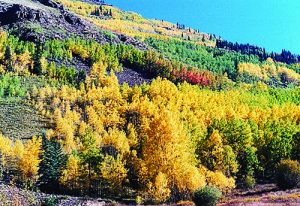
mine that made Thomas Walsh rich. If that name sounds familiar, it should. It was his daughter, Evelyn, who owned the Hope Diamond now in the Smithsonian!
Walsh was a prospector who had a couple of properties and needed silica to help beneficiate the ores he was mining. He bought the Camp Bird and while mining silica, struck it rich. The mine eventually produced some $20 million in gold, an astounding sum in the late 1800s and long before income tax time! Wash was very philanthropic, so when in Ouray visit the local library that he financed. Walsh’s daughter, Evelyn, married and ended up with the Hope Diamond, which has its own list of legends and stories.
Silverton and the San Juan Mountains have one legend no other mining camp in America can boast: cannibalism! In the 1800s, gold was reported in the San Juan Mountains, and a small group of eager prospectors hired Alferd Packer to guide them into the San Juans.
Prospecting Tales
They got a late summer start and, while prospecting in those rugged mountains, were hit by a blizzard that trapped them for the entire winter. You can imagine the rigors of trying to survive in those high mountains in winter. They had to hunker down for the winter, but conditions were such that they all slowly starved to death. All except one: Packer.
When spring finally came, Packer was the only one to come out of the San Juan Mountains alive. Folks were really suspicious that Packer survived but were even more amazed that he looked pretty darned healthy for someone who supposedly starved through a winter in the San Juans. So a small party headed into the San Juans and what they found at the Packer camp shocked them. There were partially eaten corpses – the group Packer had guided! He had survived by feasting on his companions to get through the long winter months. By the time this was discovered Packer was long gone but he was later convicted of cannibalism, the only such case in Colorado!
One of the characters of the San Juan Mountains was Otto Mears, a railroad man. He was not a miner but became rich hauling ore. He built three narrow gauge railroads to service the gold and silver mines in Silverton and Ouray. These railroads had no passenger cars, only ore cars. But that did not discourage Otto Mears from having free silver passes made to give to dignitaries and politicians to ride his railroads. I suppose they had to either ride with the engineer or sit on the piles of gold and silver ore! His first passes were done in animal leather, but these were not fancy enough to impress dignitaries. So he had passes made of silver.
Mears Passes Highlights History
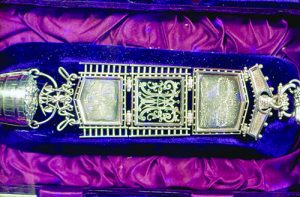
Some Mears passes were fairly simple silver rectangles nicely engraved with the owner’s name. But Mears later got really fancy and had passes made of filigreed silver with a small, solid engraved center plate surrounded by delicate silver filigree. A few were even enameled with scenery or train images. The fanciest silver pass I’ve handled had an engraved silver spoon hanging from it. The Mears silver passes have since become really special and valuable collector’s items that are extremely difficult to find.
I am familiar with many Mears silver passes and have handled many of them because my father-in-law, Morris Abbott, spent his teenage summers in Colorado and loved railroading. He made it a mission to own as many Mears passes as possible and ended up with 21 of them, probably the largest personally owned Mears silver pass collection.
The one pass Morris was never able to obtain was one of five gold passes Mears had made for his family. Unfortunately, today I know of only two gold Mears passes in existence. The others were most likely melted down in the 1930s. One remaining gold pass I knew of was owned by a Denver lawyer. The other surviving gold pass is in the Mears collection in the Denver Historical Society Museum. Those folks were kind enough to allow me to photograph their Mears gold pass years ago when I asked about it.
Turn to Locals or Intriguing Information
When I did go to the Museum and set up to photograph the gold pass, the lady in charge asked if I was also going to photograph the Otto Mears watch fob. I did not know such a trinket existed. Naturally, I agreed and the fob was brought out of the vault. It was quite an amazing trinket! Once in hand, I wondering how Mears could have ever attached the watch fob to his vest. It weighed enough to pull the vest off any man!
The watch fob is remarkable, measuring about six inches long and divided into several sections. It has two engraved gold panels hanging from it, each engraved with an important aspect of his life. Below the panels hangs a small gold miner’s bucket filled to the brim with tiny gold nuggets sweated in place. I did not weigh the watch fob, but it felt like it weighed 10 pounds!
Leadville also has its legends, many of them centered on Horace August Tabor, known as “HAW” to his friends. HAW was a merchant who eventually hit it rich in mining, becoming Leadville’s first millionaire. This made him the target for any drifter or con in the territory.
Scheming and Working In the West
One local character by the name of William Lovell came up with a scheme to get some of
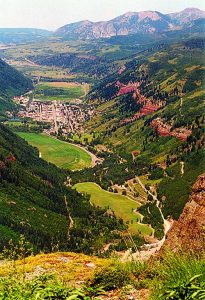
HAW’s riches. He had the idea that if he could get his hands on some rich ore and salt a worthless property called the Chrysolite, he could sell it to HAW. The Chrysotile is what Mark Twain would say, “A mine is a hole in the ground into which you throw money.”
Bill Lovell set his scam by pinching rich ore from Tabor’s own Little Pittsburgh mine and used it to salt the Chrysotile. Tabor took samples and was fooled into buying the property. But HAW had the last laugh because the tables were turned on Bill Lovell when Tabor’s miners, working what Lovell thought was a dry hole, hit a huge vein of silver. Tabor got rich and Bill Lovell got skunked!
That con is not what gave Bill Lovell his nickname, “Chicken.” When Bill was working as a drayman hauling food and supplies by wagon over the passes from Colorado Springs to Leadville, he was trapped in Wilkerson Pass by a sudden, heavy snow storm and had to hunker down. He was trapped for many days and probably would have died, except he had a ready supply of food in his wagon: a load of chickens! He had food on the hoof, so to speak, until the snows cleared enough and he could head to Leadville. When folks found out that he survived by eating his load, it was only natural to give him the name, “Chicken Bill” Lovell!
When you finish enjoying the Denver mineral shows, head west into the mountains and enjoy the natural beauty of Colorado and the lore and history of its mining camps.
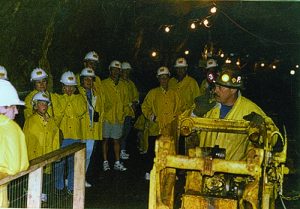
Author: Bob Jones
 Holds the Carnegie Mineralogical Award, is a member of the Rockhound Hall of Fame, and has been writing for Rock & Gem since its inception. He lectures about minerals, and has written several books and video scripts.
Holds the Carnegie Mineralogical Award, is a member of the Rockhound Hall of Fame, and has been writing for Rock & Gem since its inception. He lectures about minerals, and has written several books and video scripts.



